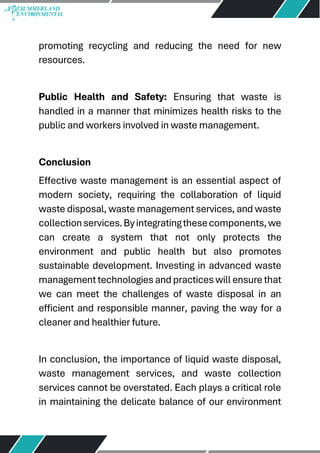Reclaim Waste - An Overview
Reclaim Waste - An Overview
Blog Article
The Ultimate Guide To Reclaim Waste
Table of ContentsThe 3-Minute Rule for Reclaim WasteSome Ideas on Reclaim Waste You Need To KnowGetting The Reclaim Waste To WorkThe Definitive Guide for Reclaim WasteThings about Reclaim Waste
Domestic sewage waste refers to the waste and items from a domestic septic container. The proper administration and disposal of residential sewage waste require liquid waste to be transferred to a sewer therapy plant where the proper techniques and tools are used to purify and dispose of waste.
Industrial waste often includes prospective threats, such as flammable materials or a combination of fluid and solid waste products, and calls for an advanced and comprehensive disposal process. The disposal of industrial waste typically involves the filtering of waste before transport to make certain safe and appropriate disposal. Hazardous waste is produced from byproducts and runoff of industrial procedures and production.
This sort of waste can not utilize the exact same sewage management transportation or procedures as septic or commercial liquids. The industrial waste administration process needs the inspection and screening of fluid waste prior to it undertakes the disposal procedure (liquid waste disposal). Drainage waste is the fluid waste that comes from overflow and excess stormwater in highly populated areas or cities
Runoff waste can create contamination and flooding if not taken care of effectively. Find out extra concerning drain cleaning and waste management. Making sure appropriate waste management can avoid catastrophes and minimize environmental damage. Both people in household setups and experts in business or manufacturing markets can benefit from recognizing the processes and policies of liquid waste monitoring.
Getting My Reclaim Waste To Work
Contact PROS Providers today to discover concerning our waste management and disposal solutions and the correct ways to look after the fluid waste you produce.
(https://reclaim-waste-48112599.hubspotpagebuilder.com/reclaim-waste/expert-liquid-waste-removal-and-disposal-services-your-complete-guide)Do you recognize what occurs to your water when you disengage, purge the bathroom or drain pipes the washing device? No? Well, it's worth knowing. This supposed 'wastewater' is not only an essential resource but, after therapy, will be launched to our land, waterways or the ocean. Made use of water from bathrooms, showers, baths, cooking area sinks, laundries and commercial processes is called wastewater.

water used to cool down equipment or tidy plant and devices). Stormwater, a type of wastewater, is drainage that streams from farming and urban locations such as roofings, parks, gardens, roads, courses and rain gutters right into stormwater drains, after rainfall. Stormwater flows unattended directly to neighborhood creeks or rivers, at some point reaching the sea.
Examine This Report on Reclaim Waste
In Queensland, a lot of wastewater is dealt with at sewage treatment plants. Wastewater is transported from domestic or commercial websites via a system of sewers and pump stations, called sewage reticulation, to a sewer therapy plant. Neighborhood federal governments develop, preserve and operate most sewer treatment plants. Operators are certified under the Environmental Protection Act 1994 to discharge treated wastewater at an acceptable ecological requirement into rivers.
The Department of Natural Resources encourages city governments regarding managing, operating and maintaining sewerage systems and treatment plants. In unsewered locations, neighborhood governments may call for owners to set up individual or household sewer treatment systems to deal with residential wastewater from bathrooms, kitchens, shower rooms and laundries. The Division of Natural Resources authorizes using household systems when they are confirmed to be reliable.
In some brand-new class, treatment of some stormwater to get rid of trash, sand and gravel has actually begun making use of gross pollutant catches. Wastewater therapy takes place in four phases: Removes strong issue.
Wastewater after that flows right into large containers where solids settle and are gotten rid of as sludge. Grease and scum are skimmed from the surface area. Uses small living microorganisms referred to as micro-organisms to damage down and get rid of continuing to be dissolved wastes and great bits. Micro-organisms and wastes are incorporated in the sludge. Removes nitrogen and phosphorus nutrients that could cause algal blossoms in our waterways and threaten aquatic life.
Reclaim Waste Fundamentals Explained
Nutrient elimination is not readily available at all sewage treatment plants due to the fact that it requires costly specialized equipment. It is ending up read more being more typical in Queensland. Clear liquid effluent generated after treatment might still consist of disease-causing micro-organisms. If this effluent is released right into rivers such as rivers or the sea, the micro-organisms will ultimately pass away out.

Most wastewater streams into the sewerage system. Under the Act, neighborhood governments administer approvals and permits for environmentally appropriate tasks (ERAs) entailing wastewater launches that may have a local influence.
A Biased View of Reclaim Waste
Otherwise, examples are considered lab evaluation. Usually several tests are required to develop the levels of each of the various contaminants such as oils, hefty metals and pesticides in water. Surveillance offers valid information concerning water high quality and can confirm that permit problems are being satisfied. The information gotten with monitoring offers the basis for making water high quality choices.
Report this page